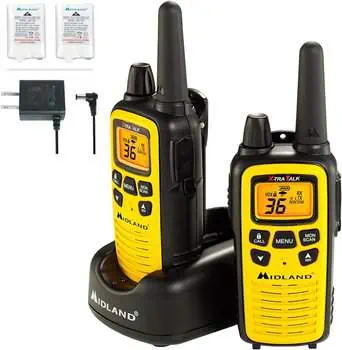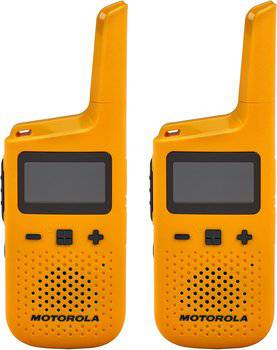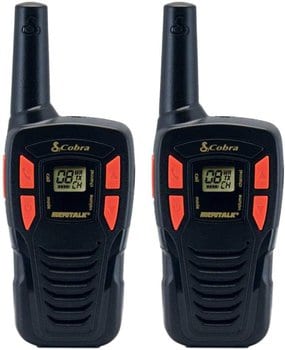Short on time? Pick Up the Backcountry Access BC Link 2.0, my #1 recommendation for one of the best 2-way radios and walkie talkies.
Cell phones have sure come a long way from the 10-pound boxes you’d have to lug around in the 80s. Nowadays, we have them practically glued to our hands, and they can pretty much do anything.
But… what if you’re somewhere without cell service? How do you stay in touch?
The answer is to use a two-way radio or a walkie-talkie, which are both powerful tools for real-time communication. Here is what we recommend:
- Best Overall 2-Way Radio: Backcountry Access BC Link 2.0
- Best Premium Walkie Talkie: Garmin Rino 750
- Best Long Range 2-Way Radio: BaoFeng BF-F8HP
- Best Radio For Families With Kids: Motorola Talkabout T380
- Best Budget 2-Way Radio: Cobra ACXT145
- Best Budget 2-Way Radio For Long Distance Talking: Midland LXT630VP3
- Best Short Range Walkie Talkie: Arcshell 2-Way AR-5
- Best Waterproof 2-Way Radio: Motorola T600
- Best 2-Way Radio for Weather Alerts: Midland GXT1000VP4
- Best 2-Way Radio Value w/ Great Battery Life: Radioddity GD-73A
Best 2-Way Radios & Walkie Talkies For Mountains:
Backcountry Access BC Link 2.0
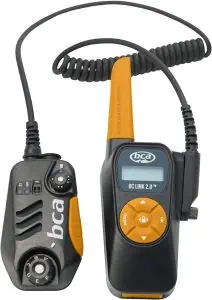
Talking Range: 40 Miles | Battery Life: 40 hours | Battery Type: 1 Lithium Ion battery | # of Channels: 143 | Water Resistance: Waterproof
With this model by Backcountry Access, battery life is not something you should be worried about. While in standby mode, the battery lasts up to 400 hours.
Of course, how long yours will last depends on how much the radio is used throughout the day. Nonetheless, you won’t have to charge it very often.
Another thing that definitely stands out about this model is its ease of use.
It features preset channel and privacy code combinations, which is something you need to set up for yourself on most radios.
The design is also pretty simple and straightforward, so you might never look at the manual.
Pros
- Up to 400 hours in standby mode
- 40 hours of battery life
- Preset channel and privacy code combinations
- Performance unaffected by bad weather
- External mic can be attached to your clothing for easier use
Cons
- Relatively expensive
- Somewhat bulky and heavy compared to other picks
Best for: campers looking for a hands-free radio
BaoFeng BF-F8HP
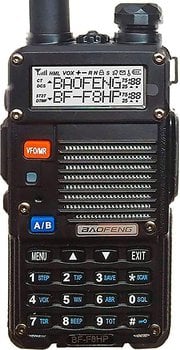
Talking Range: 80 miles | Battery Life: 18 hours | Battery Type: lithium-ion battery | # of Channels: 1000 | Water Resistance: Waterproof
Let’s start with the BaoFeng BF-F8HP, which is my favorite out of the five. I chose this unit because of its wide variety of settings and even wider range. This radio is a beast when it comes to performance but is still small enough to fit comfortably in your hand or backpack.
Using this radio is user-friendly thanks to its included CHIRP software. For radio neophytes, many pro-tier radios require frequency programming to make it communicate correctly. CHIRP is an easy-to-use desktop software that walks you through the programming process effortlessly. Also, BaoFeng provides second-to-none documentation and on-demand concierge support exclusively for its BF line of products.
Moving to the exterior, this radio is very durable and sturdy despite its size. At first glance, it might look like it’s made out of cheap plastic, but after opening the box, you’ll be impressed by its hard and compact shell that will definitely last for a long time.
The one caveat of this tool is that you may need proper licensing and training to operate it due to its power & frequency range. Depending on where you live, check with local laws & ordinances (or else my lawyer will not be happy).
If that seems too complicated, read on for walkie-talkies that don’t require any setup.
Pros:
- 400-520 MHz frequency range
- Small and compact
- Clear sound quality, and 80-mile range
- Good battery life for moderately heavy use
Cons:
- Takes a few steps to setup
- Needs proper licensing and training
Best for: Professional operators who want a top-of-the-line product and don’t mind programming their radios.
Garmin Rino 750

Talking Range: 20 miles | Battery Life: 18 Hours | Battery Type: Lithium-ion battery pack or four AA batteries | # of Channels: 22 | Water Resistance: Waterproof
If you’re willing to invest more in a 2-way radio, this model by Garmin offers everything you need and more.
Aside from providing PTT communication, it also works as a GPS navigator. This can allow you to share your waypoints, tracks, and routes with your partner.
The large, dual-orientation touchscreen is glove-friendly and readable even in bright sunlight.
Other cool features of this radio include the compass, barometric altimeter, weathercast, calendar, and even custom-map compatibility.
What more could you need?
Pros
- High-sensitivity GPS
- Emergency alert reporting
- Custom-map compatible
- Sunlight-readable touchscreen
- Position Reporting capability
- Dual battery system
Cons
- Very expensive
Best for: campers in need of a multifunctional gadget
Midland LXT630VP3
Talking Range: 30 miles | Battery Life: 6 hours | Battery Type: 2 AAA batteries required. | # of Channels: 22 | Water Resistance: Waterproof
While the Cobra is affordable and accessible, it might not be powerful enough for long-distance missions. A good hybrid between affordable walkies and rugged HAM radios is the Midland LXT630VP3.
This radio is powerful enough for any needs with its range of up to 30 miles or 48 kilometers for open range areas. The digital display on the radio is beneficial in case you need to check for activity.
These walkie-talkies also have 30 FRS(Family Radio Service) channels, making it easy to segment your communications. This also helps communicate with a broader group of people, as other manufacturers make FRS-compatible devices.
The Midland LXT630VP3 also has an NOAA weather alert feature that gets updates about weather conditions that can hinder outdoor activity. This is super useful for long-distance hiking, where you don’t have Siri to tell you the forecast.
This radio is popular because of the simplicity of its functions. Its weight and size are just perfect for an adult or even a younger child, making it a customer favorite. Plus, the functionality of the radio enormously exceeds its low price point.
Pros:
- The most amount of power available without a license
- Lightweight and easy to use
- Clear sound quality
- Great frequency range
- Rechargeable and long-lasting batteries
- Budget-friendly
Cons:
- Channel scanning isn’t as fast as a professional radio but still works.
Best for: Serious outdoorsmen who want some hutzpah in their walkie but don’t want to learn to program.
Motorola Talkabout T380
Talking Range: 25 miles | Battery Life: 18 hours | Battery Type: Rechargeable | # of Channels: 22 | Water Resistance: Waterproof
If you like the Midland’s power but want a little more rugged model, the Motorola Talkabout is an excellent choice. It’s a bit more expensive than the Midland model, but will last you longer.
This is great for the outdoors due to its rugged exterior. It’s easy to find and hard to break.
When it comes to performance, the Motorola T380 provides a range of up to 25 miles of coverage. It has an eVOX feature for hands-free operation, perfect for outdoor activities like hiking or fishing. For added call clarity, this radio has a headphone jack for headset compatibility.
The Motorola T380 also covers various features such as NOAA weather channels for emergency alerts quiet talk mode ideal for hunters that require silence when spotting prey.
This radio is very appealing to the eye because of its yellow faceplate and ergonomic design, reminding you of old school Nextel phones. They might be a bit wider than other small walkie-talkies, but many enjoy this because it’s easier to grab.
Pros:
- 18 hours rechargeable battery life
- Frequency range up to 25 miles
- Easy to deploy and use
- Hands-free feature
- Affordable price
Cons:
- The range is pretty sensitive to the terrain you’re working on
Best for: Parents with young children doing outside activities such as hunting, camping, etc.
Arcshell 2-Way AR-5
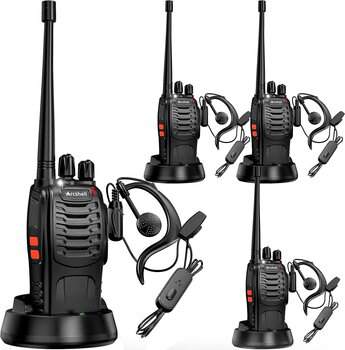
Talking Range: 5 miles | Battery Life: 4.4 hours | Battery Type: 4 Lithium Ion batteries required | # of Channels: 16 | Water Resistance: Waterproof
If you’re looking for a radio with a lightweight price tag and extensive power, the Arcshell Two-way AR-5 is an excellent choice. I highly recommend this product, but the downside is that it skimps out on bells & whistles to lower the price. This means that it doesn’t have weather updates or a display, but it still has excellent performance at a low price.
Despite its limited 5-mile range, it can transmit messages with clear and commendable sound quality. Moreover, its overall build makes the radio very easy to carry and fit comfortably in one’s hand. Not to mention, its low price makes it incredibly competitive with budget models from higher-end brands.
However, this walkie suffers from short battery life, which may not be suitable for campers who plan to spend long trips outdoors. Still, you can quickly solve this problem if you don’t mind bringing some spare batteries.
Pros:
- Budget-friendly price
- Superior sound quality
- Great customer service
- Comfortable to hold and carry
- Secure attachments and build
Cons:
- Not the best battery life
- Minimal range
Best for: Campers looking for affordable, short-range walkies.
Motorola T600
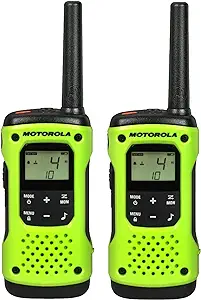
Talking Range: 35 miles | Battery Life: 9 hours | Battery Type: 4 AA batteries required | # of Channels: 22 | Water Resistance: Waterproof
With a waterproof model like this one by Motorola, even the heaviest rain is none of your concern.
In fact, this radio will work even after being submerged up to 3 feet – which is not something to worry about either, since the radio floats on water.
Actually, you get two radios in a pack – for you and your camping partner. Both also feature a flashlight with white and red lights.
The white setting helps you light the way at night, while the red is for unexpected emergencies or preserving night vision.
Pros
- Waterproof and submersible up to 3 feet
- Floats on water
- Features red and white LED lights
- Comes in a set of 2
Cons
- Menu navigation not very straightforward
Best for: activities in a wet environment, like kayaking or fishing
Midland GXT1000VP4
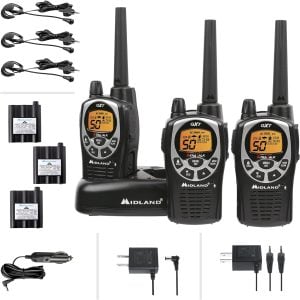
Talking Range: 36 miles | Battery Life: 9 hours | Battery Type: 1 Lithium Metal batteries required. (included) | # of Channels: 50 | Water Resistance: Waterproof
This 2-way radio offers all the important features for an affordable price.
First, it has a 36-mile range, which is quite impressive. Plus, you have 3,000 channel options and the ability to make yours private.
The radio also features NOAA Weather Scan with 10 weather band channels and ring alerts for severe weather conditions.
As for the design, it’s completely waterproof. So, you can use it even when enjoying water activities or camping in the snow.
Pros
- Very affordable
- 36-mile range
- 3,000 channels (plus a private one for you)
- Animal call alerts and vibrating mode
- Weather channels
Cons
- Battery indicator isn’t very accurate
Best for: campers on a budget
Radioddity GD-73A
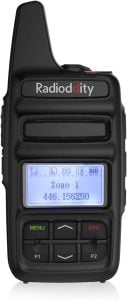
Talking Range: 5 miles | Battery Life: 48 hours | Battery Type: 1 Lithium Ion battery | # of Channels: 64 | Water Resistance: Waterproof
This model by Radioddity is one of those radios you can’t go wrong with.
It might not have tons of bells and whistles, but this is simply a really good gadget with a decent price tag that does the job.
The battery lasts up to two days in standby mode, which you can quickly charge via a micro-USB cable.
The radio is rather compact and lightweight, so it’s perfect for any pocket.
The keypad features large buttons, which make one-hand operation easy.
Pros
- Compact and lightweight
- Decent price tag
- Micro-USB charging
- 18-months-warranty and 60-day, no-reason return policy
Cons
- Has a slight learning curve
Best for: campers in need of a radio with basic functions
Cobra ACXT145
Weight (lbs): 2.24 ounces | Dimensions: 1.46 x 1.96 x 5.16 inches | Frequency: 462.55 to 467.71 MHz | # of Channels: 10
Suppose you’re looking for a reasonably priced radio that doesn’t require any programming. In that case, the Cobra ACXT145 might be the best radio for you.
The standout feature of this radio is its size. Even if your backpack is filled to the brim, you’ll be able to squeeze this bad boy in without adding too much weight. No matter how much stuff you bring, you won’t feel like carrying a rock when you’re packing this.
Next, this radio may be tiny, but it provides an excellent frequency range from 462.55 to 467.71 MHz. It also has different tones so you can distinguish calls from oncoming channels. There is also a confirmation tone that signals when it is clear to talk. These features make it that this budget kit has powerful tools equipped.
The downside of this radio set is that it’s not programmable. However, for most campers, that’s a good thing!
Pros:
- Small and lightweight
- Long battery life
- Great frequency range
- Easy to use
- Inexpensive
Cons:
- Not the most weather- or drop-resistant radio.
Best for: Casual campers that don’t need heavy programmability.
Things To Consider Before Buying A 2-Way Radio
At this point, you might be ready to buy a two-way radio or walkie-talkie.
However, you’re still on the verge of indecisiveness when it comes to actually pulling the trigger.
Read on to find out exactly what to consider when choosing the right walkie-talkie for you.
Walkie-Talkies Vs. 2-Way Radios
Now, these two terms are often used interchangeably. And that’s not always wrong.
You see, all walkie-talkies are actually 2-way radios. However, not all 2-way radios are walkie-talkies.
2-way radios can operate in two modes:
- Half-duplex – the radio can transmit or receive in turn, but can’t do both simultaneously.
- Full-duplex – radio can transmit and receive at the same time.
A walkie-talkie can only operate in half-duplex mode. But that’s not the only way it’s different from other 2-way radios.
A walkie-talkie is an unlicensed device, which you can buy in most retail outlets.
For that reason, it’s considered to be an inferior version of 2-way radio, as it’s designated for non-commercial use.
Walkie-talkies also have a shorter range and fewer features than 2-way radios. They usually have a cheaper build, which also makes them more affordable.
Walkie-talkies operate on one of the eight PMR 446 frequencies, meaning you can use them without a license.
Finally, as the name suggests, a walkie-talkie is a portable handheld radio. A 2-way radio, on the other hand, can also be a mobile vehicle radio or a wall-mounted base station.
When it comes to range, 2-way radios have better range and tougher build quality, as they’re designated for commercial use, from construction to safety enforcement.
2-way radios need a license to operate on specific frequencies, but that means you can use them without being interrupted by other users. That’s a luxury walkie-talkies don’t have.
| Walkie-Talkie | 2-Way Radio |
| Shorter range | Longer range |
| No license required | License required |
| Budget build | Heavy-duty build |
| Half-duplex mode | Half-duplex and full-duplex mode |
| Portable | Portable or base station |
| Limited frequency | Channel exclusivity |
Range & Clarity
This should be the first thing you should consider.
Depending on your use case, a model’s range could be the limiting factor dictating what you end up purchasing.
A walkie’s range is crucial as a low-range radio will be unable to transmit far distances or when obstacles are in your way. It also needs to withstand poor weather, which your basic Walmart walkie might not be able to handle.
If the range is a top priority, splurge on a higher-end walkie, or even consider adding an antenna to your radio.
Also remember, that radio range will be correlated with call clarity. The higher the comms field, the usually better the sound will be, so keep that in mind.
Ease Of Use
Aside from range and clarity, you need a walkie that’s easy to use.
If your radio takes a Ph.D. to operate, it’s unlikely you’ll use it much. On the other hand, most of the high-performance radios require programming, so balancing the two is essential.
I started this article by suggesting a programmable HAM radio for those who want peak performance.
If reading that description makes you start doubting your education, don’t fret, and just buy one of the later suggestions. That way, you won’t have to go through training, programming, or licensing.
Newbies should buy a more affordable (and thus, lower performance) radio.
That way, you don’t buy something you don’t end up using, and you can ease into the world of radio communications.
Weather Resistance & Durability
In addition to the ease of use, weather resistance, and durability also need to be considered when buying two-way radios.
Your walkie needs to withstand extreme stormy conditions and have a rugged casing to prevent water from entering (and breaking) the device.
Some two-way radios claim to be water-resistant, but that label is not a one-size-fits-all solution. Many are only water-resistant for a certain amount of time or depth.
So, it’s possible your walkie is “water-resistant” but will still break if you go scuba diving with it.
Material is also a crucial factor to consider regarding durability. Plastic might all look the same on the outside, but it’s essential to put your hands on the radio to feel if it’ll stand being dropped on a rocky trail.
The best radios to choose from are those that are lightweight but made of strong materials. These indeed are the best of both worlds, so I tried to find suggestions that match these criteria.
Battery Life & Type
Lastly, consider how long you’ll be out in the woods before buying your radio, as battery life is crucial.
Some walkies are powered by alkaline batteries, while others have rechargeable ones.
Your specific application dictates which one you’ll want to decide on.
If you’re going on a trip without any power plugs, regular alkaline batteries might be the best option. Or, make sure you pack a portable battery pack to recharge your lithium batteries. Either way, consider your goal before buying.
FAQs
Do Walkie-Talkies/2-Way Radios Work In Mountains?
Most two-way radios should work in the mountains, but with less range than they would have in flat terrain without obstacles.
As for walkie-talkies, most will work only a short, uninterrupted distance.
Should I Get A Walkie-Talkie Or A 2-Way Radio For The Mountains?
A two-way radio is a much better choice, given that it has a longer range and is less affected by obstacles compared to walkie-talkies.
What Radio Frequency Works Best In Mountains?
The best frequency for mountain regions is VHF-Low Band which is 30-50MHz, as the signals will bend more than any of the other bands, which is suitable for the obstructions you’ll encounter.
What 2-Way Radios Have The Longest Range?
Models like Midland LXT630VP3 and GXT1000VP4 offer a range of above 30 miles, which is quite impressive for such a gadget.
Who Makes The Best Walkie-Talkie?
In our opinion, Midland makes great walkie-talkies. They’re rugged, have a long range, and have plenty of channel options.
Our Verdict
You can’t go wrong with the Backcountry Access BC Link 2.0.
Its features and capabilities are top-of-the-line, but this set won’t hurt your wallet.
With great battery life and a 40-mile range, you get the best overall bang for your buck.





